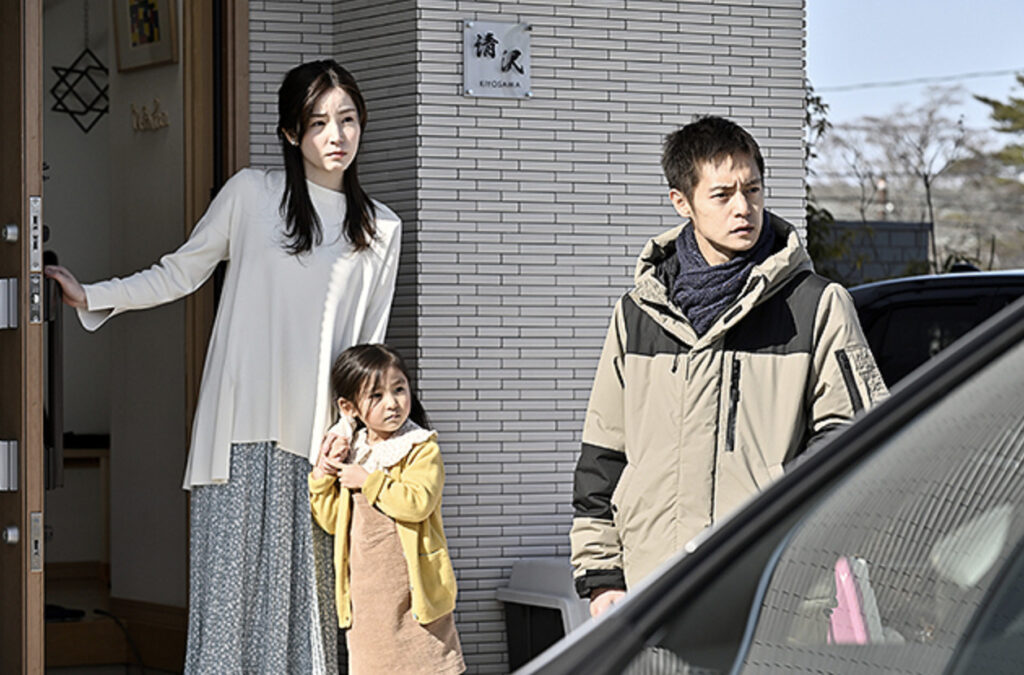
Actor Takumi Saito directs this film adaptation of Rinko Kozu’s horror suspense novel “Sweet My Home,” which won the 13th Shosetsu Gendai Feature Film Newcomer Award in 2018.
Synopsis : Kenji Kiyosawa, a sports instructor, buys the house of his dreams for his beloved wife and young daughter. The house, which heats the entire house with a huge heating system in the basement, is an ideal property in Nagano Prefecture, where winters are cold, as the house is called “Maho no Ie” (house of magic). The Kiyosawa family begins a happy life in their own home, but their happiness turns to fear when a mysterious event occurs.
Masataka Kubota plays the main character, Kenji Kiyosawa, and the cast includes Misako Renbutsu, Nao, Yosuke Kubozuka, Ayumui Nakajima.

(C) 2023 “Home Sweet Home” Production Committee (C) Rinko Kamizu / Kodansha
Exclusive Interview with Director Takumi Saito
Q: “Sweet My Home” is a film adaptation of the novel of the same title by Rinko Kamizu, which won the “13th Shosetsu Gendai Newcomer Award.” The book was also highly praised by novelist Mitsuyo Kakuta and manga artist Junji Ito. What attracted you to the original that led you to tackle a feature film?
Takumi Saito: When I received the offer, I first wondered if I would be able to direct a film in this genre.
The story was so gruesome that there were many moments when I closed the pages and stopped reading. I was doubting whether I should really make this into a film, so it wasn’t something I was going to accept right away. But as we went into the pandemic, because we were all confined to stay home for a long time, I heard there was violence happening in the home through the TV news.
I also learned that there were people who felt everything was happening in their homes, where they were supposed to be a sanctuary. There were many aspects of this original book that couldn’t be surpassed, but I thought if some thing could be surpassed, it would be the chemical reaction that occurs between flesh-and-blood people — the actors.
As a colleague of those actors (Saito is a well-known actor in Japan), I knew how great they were. I knew the individual specs of these actors. I also had cinematographer Akiko Ashizawa come in who’s a regular working on Kiyoshi Kurosawa’s films. The first major condition was whether these people would say “Yes.” So with Ashizawa and this casting in place, I could arrive at my vision of the film I wanted to make.
Q: You worked with screenwriter Kuramochi-san on the film, “Zokki.” Though you didn’t write the screenplay for this film, what was the exchange of opinions you had with [Yutaka] Kuramochi regarding the script. How did you incorporate the original story into the screenplay?
Takumi Saito: As in the case with the movie “Zokki,” one condition for a film with an original story was that it was difficult to capture the intention of the original story without distorting it. With that movie, the tone was the same as that of its author Hiroyuki Ohashi, so screenwriter Kuramochi, did some ultra C [meaning an amazing feat, or something earth-shattering — the term was originated by the Japanese Olympic gymnastics team for the 1968 Summer Olympics], such as making this into one city and by connecting other stories.
I thought that, “If Mr. Kuramochi is the right person, I will do this film.” Then, I saw a play featuring actress Nao as a guest performer in a theater company organized by Kuramochi. As a result, I decided that Nao was the right person to play this difficult role. In fact, the most crucial aspect of the script was what to do with the role of Honda. At the risk of spoiling the story, we were able to take a very different approach from the original story in terms of how we structured the flow of finding the culprit.
Of course, because the original story was not intended to be written for a two- hour film; it was written from the perspective of three different people. The book was like the film, “Monster,”[Hirokazu Kore-eda’s latest film] which took three different angles towards a single event. 70% was seen from the main [character’s]
viewpoint and the other two [characters were shown] at a slight 30%. The content was more shocking, when it was seen from the other viewpoint, so it was Kuramochi’s greatest achievement to make the story more like Yuji Sakamoto’s screenplay on “Monster” with its three different perspectives. Kuramochi made it into one world view.
Q: You and Kubota worked together on the TV series, “Criminologist Himura and Mystery Author Arisugawa.” Kubota has done a wide range of performances, from playing a boxer to playing a young man who has trouble expressing himself in words. What elements did you find attractive about him after working together and why did you offer him this role?
Takumi Saito: I had wanted to work with Kubota someday, but that wasn’t the entry point for this film. Even if I had no connection with Kubota, I think he’s the person I would have ended up with. In carefully selecting the cast for this film, he was the best choice for this film regardless of knowing him or not. His character Kenji is not a man to be admired, and as in the original book, though he’s handsome, he’s a person who can play such a fine line that audiences can’t completely detach themselves from what he does in this film.
I thought there was a very limited number of people who could play the character with such nuance that it couldn’t completely separate the character from him. People can have many personalities, but this is a unique character. It’s not that you dislike him when you see his other side, but Kubota could express a fine line [connected to the story] that makes you want to put your hand on your heart while watching him play this role.
I didn’t order Kubota to do anything, but he understood the original story and script, started rehearsals early on, and watched the rush footage as it had been shot. He did a lot of development work; at the same time, as we were finishing up he understood what was required of him in terms of expression even better than I did. If an actor couldn’t perform with this fine line of distinction, I don’t think he could have expressed the kind of presentation expected and maintained it until the end.

(C) 2023 “Home Sweet Home” Production Committee (C) Rinko Kamizu / Kodansha
Q: In this film, the house is marketed as a magical place with a single air conditioner that works every corner of the house. In depicting a model house in this film, did you do preliminary research on what model houses exist today? Did you add any other elements to the original story?
Takumi Saito: To create a smart home feel that wasn’t depicted in the original, it was a coincidence that I had been doing advertising for a housing company Hinokiya, for the past five years And, I was in charge of the “Z Air Conditioning” — a single unit that covered every corner of the house. I, and my agency, thought it was a risky decision because of the film’s content but rather than getting a sponsorship, we asked Hinokiya to cooperate in finding the location for shooting by including a model house. It was a positive thing that we received a lot of information from them. What I wanted to depict most was the feeling of emptiness
that comes from living in a place where there’s no history of human habitation. There are plenty of films that depict spirits living in historic Japanese houses, but I thought that the most important thing to show in this film was the sense of emptiness that comes from living in a newly built, somewhat inorganic, and uninhabited house. I used the film, “Vivarium” starring Jesse Eisenberg and “The Servant” — executive produced by M. Night Shyamalan — as references. I wondered if it would be possible to depict the eeriness of the blank spaces between the home and its neighbors.
I wanted to create a work in which an inorganic thing somehow harms something organic or human, so the smart home offered a highly convenient notion, with the analog part lost because of it. I wanted to create a work that would be imbued with such a sense of emptiness. On the other hand, Kenji’s parents’ house has a long, but negative history. I wanted to create a contrast between a space where people have accumulated a history and a place without such a history.
Q: In this film, Miss Honda [played by Nao] says to Hitomi [Misako Renbutsu], “This is an ideal family.” On the surface, Kenji appears to be kind to his wife and caring about his children, but in reality, he’s unfaithful and has many dark elements about him. We see so often that some people have posted pics which aren’t true depictions of who they are. What does this ideal family mean to you?
Takumi Saito: The original author, Rinko Kamizu, was a dental hygienist and became a housewife when she got married and had a baby. However, she felt unfinished in her life; she wanted to write a book. She was greatly influenced by Stephen King, so she started a book with the layout of this home [in mind]. The family relations, or rather the members of the family, remain the same as in Kamizu’s family, so from our perspective, I think her family is kind of meant as an ideal as well. Kamizu said that there was no dissatisfaction among her real family, but the characters created by her imagination did terrible things on their own.
She said that in her story, the characters developed themselves. Somewhere in her mind she was aware of the notion of being seen as an ideal family member. However, the photos that many people uploaded to social networking sites, and the photos that weren’t uploaded but were erased, that is where reality lies. I wonder if we’re in a modern age where we are stepping into the virtual a little bit, where everyone knows that there’s realism in such things as dead eyes in a photo. I think that animals and babies transcend such [virtual] things, but I don’t know what kind of place it is — whether happy or unhappy. Unlike adults, they’re not conscious of what others think of them; they make honest judgments about the concept of happiness.
I also try to include children and animals in people’s homes, thinking that the sense of smell of babies and animals, which also appear in this film, may point to the essence of this film. I wonder if there’s a reflection of the home there. I don’t think we dare look at the other side, but I really think that having to be confined to one’s home [due to the Covid] caused really different reactions from one family to another. There were so many negative incidents such as the many young men and girls who left their homes due to the pandemic; I thought that the depiction of the family in this film — though not aimed at Japanese culture — reveals the color or tone of Japanese society. And that’s a sad admission.

(C) 2023 “Home Sweet Home” Production Committee (C) Rinko Kamizu / Kodansha

